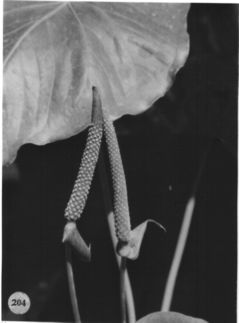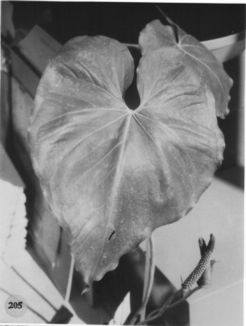





Anthurium titanium Slandl. & Steyerm.,
Publ. Field Mus. Nat. Hist., Bot. Scr. 23: 211. 1947. TYPE: Guatemala. San Marcos: south facing slopes of Volcán Tajumuleo, above Finca El Porvenir, along Río Cabuz to within 2 mi of Cueva de las Palomas, alt. 1,300-1,500 m, March 16, 1940, Steyermark 37963 (F, holotype).
Epihytic or terrestrial; stems short, 2-4 cm diam.; leaf scars 2.5-2.8 cm wide; roots thick, tan, 5-6 mm diam.; cataphylls subcoriaceous, 4.5-12 cm long, round to weakly emarginale at apex with a conspicuous subapical apiculum ca. 2mm long, drying medium brown (B & K Yellow 4/7.5), weathering into coarse fibers.
Anthurium xanthosomifolium Matuda, Revista Soc. Mcx. Hist. Nat. 11:92.1950. TYPE: Mexico. Chiapas: Municipio Sillepec, Cascada, on wet rock at 1,800 m, April 11, 1949, Matuda 18644 (MEXU, holotypt: DS, isotype).
LEAVES with petioles erect-spreading, 31-90(112) cm long, 5-10(15) mm diam., D-shaped, sometimes weakly sulcate and glaucous; geniculum 1.5-4 cm long; blades moderately thick, ovate to broadly ovate or nearly round, abruptly to gradually acuminate at apex (the acumen apiculate 2-7 mm long), deeply lobed at base, 27-120 cm long, 29-80 cm wide, broadest at middle or just below, the margins sometimes markedly undulate, weakly revolutc; anterior lobe 19-100 cm long, the margins broadly rounded; posterior lobes 10-40 cm long; sinus obovate to hippo-crepiform, acute to rounded at apex; both surfaces semiglossy; midrib convexly raised above, more acutely raised below, narrowing and diminishing, ± flat at apex above; basal veins 1÷ 10 pairs, the first and second free to base, those remainingcoalesced 2-4(7) cm, raised above and below; posterior ribs conspicuously upturned, naked; primary lateral veins 3-5 per side, departing midrib at 45° angle, ± straight to collective vein, loop-connecting to collective vein, weakly raised above and below; interprimary veins conspicuous, flat above and below, lesser veins visible; collective vein arising from the first basal vein in smaller blades or one of the primary lateral veins in the larger blades, weakly sunken above, raised below, 7-15 mm from margin.
INFLORESCENCE erect-spreading, as long as or shorter than leaves; peduncle 26-47 cm long, 7-15 mm diam., terete; spathe subcoriaceous, green, faintly to heavily tinged red-violet, broadly lanceolate, (5)9-26 cm long, 1.8-3.2 cm wide, broadest just above base, long-acuminate at apex, inrolled 1-2.5 cm, rounded al base, inserted at 25°-30° angle on peduncle, held al ca. 45° angle from peduncle; stipe 5.5-9 mm long in front, 4.5-7 mm long in back; spadix olive-green (B & K Yellow-green 5/5), sometimes weakly to heavily tinged red-violet, (6)11-24 cm long, 1-3 cm diam. at base, 5-10 mm diam. al apex; flowers rhombic lo sub-4-lobed, 3.7-5 mm long, 3.8-4 mm wide, the sides ± straight lo weakly sigmoid; 7-10 flowers visible in the principal spiral, 6-13 flowers visible in the alternate spiral; tepals matte, minutely papillate, lateral tepals 1.8-2.9 mm wide, the inner margin broadly rounded, thin, paler green; pistil green, emergent, raised; stigma linear, 0.7 mm long, ca. as long as pistil; stamens emerging at base, 3 or 4 stamens emerging in the first 2-3 spirals before first emerges in next spiral, held over pistil, retracting to edge of tepals before opening; filaments weakly exserted, translucent, as wide as anthers; anthers pale yellow, 0.9-1.2 mm long, 1.2-1.4 mm wide; thecae ellipsoid, scarcely divaricate; pollen cream.
INFRUCTESCENCE probably with orange berries. Figs. 204 and 205.
Anthurium titanium is endemic to a small area in southeastern Chiapas in Mexico and adjacent western Guatemala in the Department of San Marcos from 900 to 1,800 m, mostly from 1,300 to 1,800 m
The species is a member of section Belolonchium and is
characterized by its broadly ovate to subrounded blade with prominent posterior
lobes and a weakly glaucous petiole, D-shaped in crosssection.
The species is probably most closely related to A.
montanum, with which it is sympatric and shares a similar leaf
texture and coloration, weathered cataphylls, and petioles that arc usually
D-shaped in cross-section and somewhat glaucous. The latter species diners
in having a narrowly ovate blade which is generally smaller than A.
titanium.
The type specimen is unusually large (perhaps twice as large as other
collections in most aspects) but otherwise compares well with the material
from Chiapas described by Matuda as A. xanthosomifolium. The species
is by far the largest Anthurium in Mexico.
 |
 |
Mexico Chiapas: 1600 m,, 3 March 1945, Matuda 5077 (LL).
Mexico Chiapas: 550 m,, 27 August 1996, Thomas B. Croat 78726 (MO,
NY).
Mexico Chiapas: 1400 m,, 11 Feb. 1979, Croat 47253 (NY). Mexico Chiapas:,
Jan. 1918, Matuda 18628 (NY).
Mexico Chiapas: 1700 m,, 21 Apr. 1950, Matuda 19668 (NY).